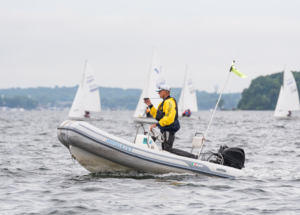The How & Why of Sailing
By Gordy Bowers

I believe the how and why of sailing should be taught using the following concepts in order:
- Wind strength and direction
- Course heading angle and apparent wind
- Helm pressure: balance and imbalance
- Sail trim and shape
- Sailor form and movement
WIND STRENGTH & DIRECTION
All sailors want to see and feel the wind like the Seagull, the Hawk and the Pelican.
The first step is wind strength awareness. Start by looking closely at the small ripple marks that look like fish scales made by wind pushing on the water surface. If they are close together there is more wind. When further apart, less wind. In winds of one to six miles per hour the water surface is flat with ripples about 1/8 inch high. There may be smooth sections that have less wind. Weight will be to leeward to keep hull wetted surface low and shape your sails.
As the wind velocity increases to from six to twelve knots (medium winds) small waves and chop up to one foot high will appear. There may also be some white caps. Between ten and twelve miles per hour sailing upwind close hauled you will begin hiking to maintain the correct heel angle for your class of boat.
At twelve to eighteen (medium-heavy air) waves become higher—one to two feet and longer. The frequency and width of the white caps also increases. Over twelve knots most boats become overpowered so hiking alone will not maintain correct heel angle. Become more aware of wind pressure on your face —increasing, decreasing or steady.
As the wind increases over eighteen the waves become even higher depending on how far you are from the windward shore. On Lake Minnetonka with a maximum fetch of three miles waves will max out at about two to three feet high. On Lake Michigan when the wind comes onshore from a long distance waves can be five feet high or more.
Again, the ripples will always be on the wave surface. The more wind the more dense will be the ripples. When winds are medium to heavy you have to anticipate the gusts, flatten sail and ease the main and/or jib sheet. Steering should be more aggressive as you react to wind and waves.
When sailing upwind I look for patterns at three different levels. At fifteen feet to fifty yards out I am narrowly focused on the ripples and waves coming at the boat. At this distance at least five seconds are needed to react with helm, sheet and weight movement. Second, from fifty up to four hundred yards I will be observing the leading edge of the puffs for speed, shape and direction.Thirdly, beyond four hundred yards is the long range forecast distance where you should look for small light and dark differences through a ninety degree range – left, middle and right. The best racers stand up before the start to get a better view of the puffs and lulls.
The distances are shortened down wind because your boat is sailing away from the wind. Also, the puffs and lulls feel less intense because your apparent wind is less. You must look aft more often to see the new wind coming.
Practice looking so you see the wind like the birds.
